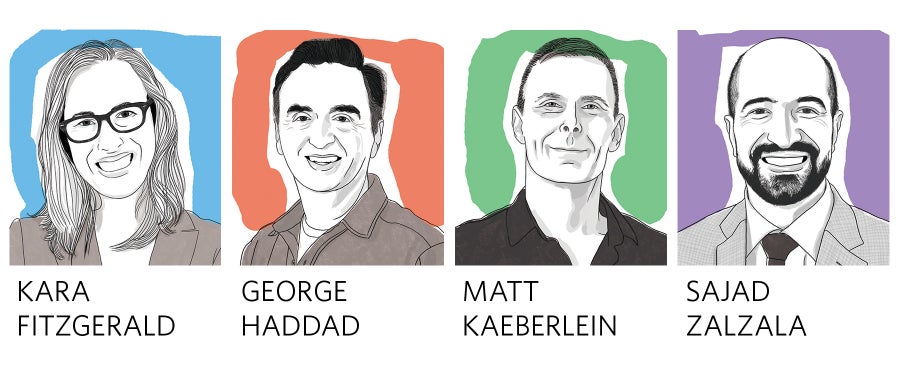George Haddad had some alarming news for his new 34-year-old patient. After taking a blood sample, the Seattle-based longevity doctor had run a trio of biomarker tests designed to measure his client’s “biological” age: The patient had the blood of a middle-aged man.
“He looked like he was in his 40s,” recalls Haddad, a physician specializing in internal medicine and cofounder and chief medical officer of Optispan, a Seattle-based healthspan technology company that operates a brick-and-mortar clinic with a telehealth option. “When we did the testing on him, he was consistently 10 years older across the board.”
Haddad is part of a growing cadre of doctor-entrepreneurs who are embracing a new healthcare paradigm with a tantalizing promise: that by taking certain actions, it may be possible to reverse aging, live longer and extend a state of disease-free living almost until the very end. Those actions range from eating more broccoli to consuming experimental medications.
Peter Attia, a best-selling author and podcaster, calls it “Medicine 3.0.” His Austin, Texas-based longevity clinic serves celebrity and high-net-worth clients willing to pay into the six figures for his services.
Medicine 2.0 refers to practices of the past few centuries up to the present. (Medicine 1.0 refers to the days when doctors didn’t necessarily know anything about science.) According to Haddad, Attia and other longevity doctors, Medicine 2.0 is based on an antiquated approach that is fundamentally defeatist: wait for things to break, and then try to pick up the pieces. It might have made sense in the 19th century, when our understanding of the human body was primitive and the tools we had to measure and characterize human biology and change it were crude or nonexistent. But thanks to a revolution in molecular biology and a slew of technologies, it no longer has to be that way.
In recent years, researchers have made dramatic progress unraveling the mystery of aging, homing in on cellular processes that go awry as we get older and fuel the negative spiral that ultimately leads to the body’s systemic collapse. Many of the doctors who practice this kind of medicine are quick to take what’s been found in the lab and bring it into the doctor’s office, so patients can make use of it in their daily lives.
Those who do so make no apologies. Their argument goes something like this: the traditional medical establishment is constrained by a conservative “do no harm” approach that fails to account for a fundamental truth: doing nothing in the face of growing scientific evidence—even if it is not yet fully validated—constitutes an action of sorts. And doing nothing can sometimes cause more harm than acting on the best available evidence.
Most of what goes on in the offices of Medicine 3.0 doctors is based on solid, mainstream science. But not all of it. Sometimes doctors make recommendations based on science that is preliminary, meaning further study is needed to confirm its safety and effectiveness or proper dosing—or reveal it to be bogus. Doctors who practice Medicine 3.0 walk a tightrope between mainstream science and exciting new findings in the lab that, as promising as they are, have not been rigorously tested.
This approach presents something of a quandary to the average person hoping to take advantage of the emerging science of healthspan, which seeks to extend health into old age as much as possible. For them, the central challenge is to figure out whether their doctor can operate on the frontiers of medicine while maintaining the proper balance between risk and reward. For that, it helps to have an idea of what’s risky and what’s not.
Testing, testing, testing
The Medicine 3.0 experience usually begins with extensive testing. The methods of testing, like the interventions that follow, fall along a continuum of respectability. On one side are long-established, widely used tools that have long been accepted in the medical community. On the other side are tests that can be speculative and experimental.
Haddad usually begins with a DEXA, or dual x-ray Absorptiometry, scan, a body composition test that uses x-ray beams to measure the amount of fat, lean tissue and bone in the body. He also uses blood tests to evaluate nutritional status and hormone levels. Then, using big data, he can compare those results to healthy norms and identify places to intervene. Is the client deficient in vitamin D, omega-3 or vitamin B12? What about levels of estrogen and progesterone, testosterone, insulin and cortisol? These are all widely accepted tools.
Less widely accepted are the biological aging tests Haddad applied to that 34-year-old.
Those tests are based on recent discoveries characterizing a number of biological changes that are associated with a decline in cellular function and that can accelerate physical decline. For instance, as we get older, certain genes get turned on or off through a process known as methylation in ways that can interfere with healthy gene regulation, which in turn can interfere with the production of proteins we rely upon to keep our cells healthy. For example, abnormal methylation patterns can lead to cancer by suppressing the activity of tumor suppressor genes. Abnormal methylation has also been linked to cardiovascular disease, autoimmune diseases and nervous system disorders.
Then there is the phenomenon known as senescence. As we age, some cells stop dividing but do not die, entering an unhealthy zombie state. These senescent cells can lead to low-level inflammation that suppresses normal mechanisms of cellular repair and creates a toxic environment for neighboring cells. And in the aging process, proteins interact with one of several forms of sugar, in a process known as glycosylation, in ways that modify their structure and function and that can serve as biomarkers. The biological tests aim to measure these changes.
As we age, cellular methylation patterns and glucosylation change in predictable ways, and senescent cells accumulate, as demonstrated in large-scale longitudinal studies, including the Framingham Heart Study, the Dunedin Study and the Baltimore Longitudinal Study of Aging. “Based on that,” says Haddad, “we can tell you whether you’re younger or older than your chronological age.”
Tests for these and other measures of biological aging are already being commercialized. A number of direct-to-consumer tests can characterize methylation patterns and glycosylation. Tests to measure senescence are harder to find, but they exist. Optispan, for instance, uses an experimental test produced by a North Carolina company to measure T-cell senescence.
Attia, for one, is skeptical of these biological aging tests, mainly because they have not been sufficiently validated. For instance, some Medicine 3.0 doctors use the Horvath clock test to assess the biological age of patients. Former UCLA geneticist Steve Horvath, who pioneered the measure of methylation patterns as a proxy for cellular aging, developed the test as a research tool. Attia insists that the test is not informative for individual patients and does not belong in the doctor’s office. “If you tell me that your birth certificate age is 65, I have a much better sense of saying, yep, I expect you to live about another 20 years,” he says. In general, tests for biological age are “not even close to ready for prime time.”
Haddad disagrees: “I can tell you from experience, these tests aren’t perfect, but there’s something there.”

Leading doctors now offer lab tests, personalized medicine and lifestyle recommendations to patients hoping to extend their healthspan.
Monica Hellström
The four pillars and the Western lifestyle
Once they assess their patients, almost all doctors who practice Medicine 3.0 begin with the basics, focusing on optimizing their diets, sleep habits, stress- reduction techniques and emotional well-being. There is nothing speculative about the benefits of these interventions—primary-care doctors often give the same advice. The difference is that Medicine 3.0 doctors put an emphasis on these steps as a way to prevent disease.
A key part of the Optispan approach, for instance, is a focus on “creating intentionality” around improving what Haddad calls “the four pillars of health: eat, sleep, move and connect.” These are similar to Attia’s four pillars of longevity (a balanced diet, regular physical activity, quality sleep and strong social connections). That’s why Haddad’s initial prescription for that middle-aged 34-year-old wasn’t particularly revolutionary and did not require fancy testing. A quick medical history revealed that his client was sedentary and rarely exercised, had poor sleep habits and was depressed, anxious and isolated. His diet consisted largely of processed junk food. “In his case, we didn’t go to medicines,” says Haddad. “For him, sleep was the low-hanging fruit. So, we worked very hard on sleep hygiene.”
Haddad also put his client on what he calls a “whole food challenge.” Bread, rice and pasta were out. Vegetables, fish, eggs and meat were in. By the time the 30-day challenge ended, he’d already lost 10 pounds and his blood sugar and lipids looked better. “If you just stop eating junk food, your biomarkers do improve,” Haddad says. “That’s not radical news.”
For Kara Fitzgerald, who runs a Connecticut-based clinic focused on longevity and improving healthspan, everything starts with lifestyle. She is a prominent voice in the field of functional medicine, in which doctors take a holistic approach to their patients, taking into account nutrition, exercise, genetics and other factors.
Beyond the basics
Beyond the tried and true pillars of diet, exercise, sleep hygiene and social connection, which have broad mainstream acceptance, there are still plenty of interventions that longevity doctors can prescribe.
Unregulated supplements have some degree of support in the medical community. No one disputes that probiotics and phytonutrients, chemical compounds found in plants like beta-carotene believed to have antioxidant properties, aim to add compounds that are known to be good for the body. But there is a lack of clinical data to establish that when they are consumed as supplements, rather than as a part of normal food, they will survive the human digestion system and liver metabolism in a form that will allow them to actually get to where they need to go to have an impact. Furthermore, since they are not regulated by the FDA and often sell so well their promoters have no incentive to test them further, they lack the rigorous double-blinded studies needed to validate them.
Fitzgerald, like many longevity doctors, prescribes supplements, and in 2021 she published the results of a small randomized controlled clinical trial in 43 healthy adult males between the ages of 50 and 72 in the journal Aging. It showed that a simple 8-week treatment program of modifications to diet, sleep, exercise, along with supplemental probiotics, phytonutrients and meditation was associated with a 3.23 year reduction in biological age, as measured by the online Horvath clock test—results not seen in a control group.
Longevity doctors are also focusing on fixing hormonal imbalances. A large percentage of people have hormonal imbalances caused by aging, and they’ve been exposed to environmental toxins, says Matt Kaeberlein, CEO of Optispan. Fixing those imbalances with hormone replacement therapy, he says, can make a big difference for a lot of people.
“Everybody in their 50s should be getting comprehensive hormonal tests at least once every few years to figure out where you’re at,” says Kaeberlein. “My view is if you need to get it fixed, get it fixed.”
Kaeberlein also suggests everybody get a DEXA body composition test every two to three years, starting in their 50s and possibly even earlier, aimed at measuring bone density, fat and muscle mass. “If you catch osteopenia and osteoporosis in your 40s, you’re going to be in a much better place in your 60s and 70s than if you don’t catch it and you fall down and get a hip fracture,” he says. “These are pretty easy to fix if you know you need to fix them.”
Prescribing boldly
Beyond the four pillars and beyond hormones and supplements lie the more controversial areas of longevity medicine, where doctors prescribe experimental medicines designed to hack the biology of aging—such as rapamycin, metformin and drugs aimed at modulating nicotinamide adenine dinucleotide (NAD), an organic molecule that plays a key role in cellular metabolism and energy production. Some of these drugs are more speculative and riskier than others. While rapamycin and metformin are approved for other uses, and have plenty of safety data behind them, some treatments, such as stem cell therapies or plasma infusions, are so experimental many doctors won’t touch them.
For those patients willing to engage with more experimental interventions, there are plenty of options. Perhaps the most widely prescribed of the experimental anti-aging drugs is the off-label use of rapamycin, a drug that mimics the effects of calorie restriction by hacking the pathway that regulates metabolism and cell division. The drug is approved as an anticancer therapy and to inhibit organ rejection in transplant patients. It has also been shown to extend lifespan in a wide array of animals, including worms and mice, and evidence is growing that it can have positive effects on dogs and humans.
Some scientists suggest that metformin, a diabetes drug used to lower blood sugar, may also protect cells from damage caused by unstable molecules known as free radicals and improve blood-vessel health, which could extend life. Experimental drugs called senolytics, designed to remove senescent cells, are promising enough to be the subject of a $125-million, five-year NIH grant program. So far, they have shown some promise in clinical trials. Also in the mix are a host of other drugs designed to modulate levels of NAD, which decreases with age. Transdermal patches that deliver the molecule directly into the bloodstream of long COVID patients suffering from chronic fatigue are being used by a number of prominent clinicians. The treatments are designed to help the patients’ mitochondria produce more energy. The results are promising, but so far anecdotal. A clinical trial to test their effectiveness is planned.
Much research remains to be done to prove the effectiveness of these drugs in people, proper dosing, drug interactions and, in some cases, safety. Since rapamycin and metformin are approved for other uses, they have enough clinical data behind them that the clinicians are confident they are safe. Both drugs, if taken without doctor supervision, could be dangerous—in rare cases, metformin can cause a life-threatening condition called lactic acidosis and is usually not recommended for those with kidney disease.
In clinical trials, about five percent of patients taking rapamycin experience side effects sufficiently grave to stop taking the drug. The FDA also stamped the drug with a “black box” warning because of its potentially severe side effects. The drug can suppress the immune system—it has long been used to suppress the immune system in people who have undergone organ transplants and to inhibit cancer cell growth—which means users run a heightened risk of deadly infections.
Still, Kaeberlein considers the interventions relatively benign, as long as they’re administered under a doctor’s supervision. The lack of definitive evidence is not by itself a good reason to avoid them, he argues.
The danger of caution
Haddad has not ruled out the use of drugs like rapamycin for his 34-year-old client. But he’s more likely to prescribe it for someone who’s already mastered the basics of self-care, as he did for a woman who came into his office one day. His impression was that she was in her mid-50s, which tests of her biological age confirmed. But the age on her driver’s license—her chronological age—was 65.
“She was someone that had everything dialed in,” he says. “She was eating an extremely healthy diet, exercised every day. Sleep wasn’t perfect, but it was good. She was a content 65-year-old who was working for fun and had lots of joy in her life. She’s like, ‘Well, I want to be even younger.’ She was greedy. That’s how some people are, which is fine.” To fine-tune her, Haddad prescribed hormone replacement therapy. He is also considering using rapamycin, because she wants to push beyond simple lifestyle interventions, and Haddad says that the potential benefits of the widely used drug outweigh the risks.
Haddad’s clinical decisions with these two patients reflects Optispan’s rethink of the “first do no harm” provision of the Hippocratic oath—the idea that doctors should, above all else, avoid harming patients. While this may be appropriate in cases where there are real dangers, Kaeberlein argues, the concept has been taken to such an extreme that it has made doctors overly cautious. And caution, when carried to the extreme, can itself be harmful.
“If you’re stuck in the mindset of reactive disease care, you’re always going to default to, well, we don’t have the randomized clinical trials, so we shouldn’t do anything,” Kaeberlein says. “And I reject that viewpoint personally. I think that’s a disservice to people.” To gauge risk in longevity medicine, Sajad Zalzala, a family medicine doctor and founder of AgelessRx, a telehealth platform that serves 40,000 patients, says there’s a need to act on ambiguous information, provided the medications don’t carry big risks, according to the available science. (He steers clear of stem cell therapies.) The results for individual therapies vary widely by patient, and finding the right interventions can take experimentation and time, Zalzala says. But they are worth the effort, he says, since lifestyle inventions alone are unlikely to result in “extreme old age.”
Medicine 3.0 doctors do agree on one therapy, which has zero side effects: placebo. “You can make a reasoned argument that if people take these things and suddenly feel better, even if it’s not the active ingredient in the supplement,” says Kaeberlein. “Is that a bad thing? I don’t know. I mean, if it helps, it helps, right?”
Explore the emerging science of healthspan in other stories in this special report.



